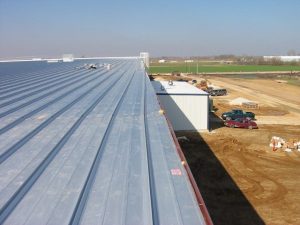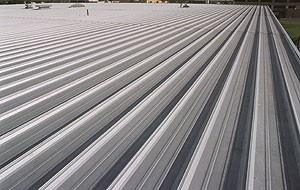- Products
- Industries
- Project Gallery
- Resource Center
- Metal Institute
- Services
- Shop
- Contact Us
May 19, 2017
by MBCI
When installing metal roof panels, the sign of a successful installation can be seen in the way the spacing and alignment of the panels are held across the entire roof. Improperly done, the appearance suffers from standing seam lines that are wavy or non-parallel to roof edges. Even worse, the panels can be unduly stressed, causing the potential for failure of water protection. Installed properly, by being diligent about spacing and holding the modular layout to be square to the building, the results are clean, straight lines that allow proper performance of the roofing system.
Here are some basic tips for installing metal roofing panels that help ensure that the module is used as an advantage for first-class work.
Before starting the roofing installation, examine the steel structure and anything else that the roofing panels attach to or are impacted by. Is the steel out of square? Are the purlins properly aligned or are they bowed? Is the plane of the substructure within the tolerance of the manufacturer’s requirements? Discovering any irregular conditions in the building will require some adjustment to determine how to assure that the roofing can be installed properly and then remedy prior to starting.
The best way to ensure that the panels stay aligned as they are installed is to establish a fixed reference line along the rake edge of the building that is square to the building eave. Then, all measurements for spacing should be made from this reference edge line. A string line can be installed from the eave to ridge running parallel to the rake. The string line should stay ahead of the work and measure from the string back to each panel run. The string line is moved ahead as the roof installation progresses.

The alignment of the roof panels can be checked every run, but at a minimum, it must be checked every three or four runs. Measure from the rake support to the seam of the last completed panel run at the eave, endlap and ridge.
Here are a few basic techniques as the work progresses:

In order to maintain the modularity of a well-installed roof, the width of the panels may need some slight adjustments. Some roof systems can be adjusted by bending the sides of the backup plates slightly to make the panel connection at then endlaps and ridges either wider or narrower, but no more than ¼” per side. Other roof systems may be adjusted with the panel clips themselves. To stretch the panel width, install the clip at the endlap or ridge with the base angled away from the panel. To shrink panel coverage, install the clip at the endlap or ridge with the base angled toward the panel.
By following some of these simple techniques and paying attention to the reference lines for the roof, any deviations and corrections can be identified right away rather than discovering the problem later and requiring rework. Overall, these tips should result in a roof that is better-looking, faster to install, and more weathertight.